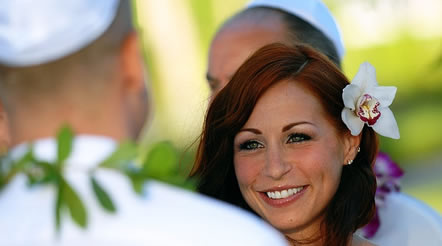
|
| Jewish
Wedding Culture and Traditions In preparing for the wedding, the chatan (Hebrew for groom) and kallah (bride) should not only pay attention to the material and temporal aspects of married life, but should focus as well on ensuring their religious, spiritual and moral readiness for the future. The following guide explains the Jewish wedding traditions to help you better understand the beauty and joy of the celebration. THE WEDDING DAY The dawning wedding day heralds the happiest and holiest day of one's life. This day is considered a personal Yom Kippur for the chatan and kallah, for on this day all their past mistakes are forgiven as they merge into a new, complete soul. As on Yom Kippur, both the chatan and kallah fast (in this case, from dawn until after the completion of the marriage ceremony). And at the ceremony, the chatan wears a kittel, the traditional white robe worn on Yom Kippur. KABBALAT PANIM It is customary for the chatan and kallah not to see each other for the week preceding the wedding. Separate receptions, called Kabbalat Panim, are held just prior to the wedding ceremony. Jewish tradition likens the couple to a queen and king. The kallah will be seated on a throne to receive her guests, while the chatan is surrounded by guests who sing and toast him. At this time there is a tradition for the mother of the bride and the mother of the groom to stand together and break a plate. The reason is to show the seriousness of the commitment -- just as a plate can never be fully repaired, so too a broken relationship can never be fully repaired. BADEKEN Next comes the badeken, the veiling of the kallah by the chatan. The veil symbolizes the idea of modesty and conveys the lesson that however attractive physical appearances may be, the soul and character are paramount. The chatan, accompanied by family and friends, proceeds to the kallah's room and places the veil over her face. This is an ancient custom and serves as the first of many actions by which the groom signals his commitment to clothe and protect his wife. It is reminiscent of Rebecca covering her face before marrying Isaac. CHUPAH The wedding ceremony takes place under the chupah (canopy), a symbol of the home to be built and shared by the couple. It is open on all sides, just as Abraham and Sarah had their tent open all sides to welcome friends and relatives in unconditional hospitality. The chupah is usually held outside, under the stars, as a sign of the blessing given by G-d to the patriarch Abraham that his children shall be as the stars of the heavens. The chatan and kallah will wear no jewelry under the chupah (marriage canopy). Their mutual commitment to one another is based on who they are as people not on their respective material possessions. The chatan, followed by the kallah, are usually escorted to the chuppah by their respective sets of parents. Under the chupah, the kallah circles the chatan seven times. Just as the world was created in seven days, the kallah is figuratively building the walls of the couple's new home. The number seven also symbolizes the wholeness and completeness that they cannot attain separately. The kallah then settles at her chatan's right-hand side. BLESSINGS OF BETROTHAL (KIDDUSHIN) Two cups of wine are used in the wedding ceremony. The first cup accompanies the betrothal blessing, and after these are recited, the couple drinks from the cup. Wine, a symbol of joy in Jewish tradition, is associated with the Kiddush, the sanctification prayer recited on Shabbat and festivals. Marriage, which is called Kiddushin, is the sanctification of a man and woman to each other. GIVING OF THE RING The ring should be made of plain gold, without blemishes or ornamentation (e.g. stones) -- just as it is hoped that the marriage will be one of simple beauty. The chatan now takes the wedding ring in his hand, and in clear view of two witnesses, he declares to his wife, Behold; you are betrothed unto me with this ring according to the laws of Moses and Israel. He then places the ring on the forefinger of his bride's right hand. According to Jewish law, this is the central moment of the wedding ceremony, and the couple is now fully married at this point. KETUBAH (MARRIAGE CONTRACT) Now comes the reading of the Ketubah (marriage contract) in the original Aramaic text. In marriage, the chatan accepts upon himself certain marital responsibilities which are detailed in the Ketubah. His principal obligations are to provide food, shelter and clothing for his wife, and to be attentive to her emotional needs. The protection of the rights of a Jewish wife is so important that the marriage may not be solemnized until the contract has been completed. The document is signed by two witnesses, and has the standing of a legally binding agreement. The Ketubah is the property of the kallah and she must have access to it throughout their marriage. It is often written amidst beautiful artwork, to be framed and displayed in the home. The reading of the Ketubah acts as a break between the first part of the ceremony -- Kiddushin (betrothal), and the latter part -- Nissuin (marriage). In preparing for the wedding, the chatan (Hebrew
for groom) and kallah (bride) should not only pay attention to the
material and temporal aspects of married life, but should focus
as well on ensuring their religious, spiritual and moral readiness
for the future. |
